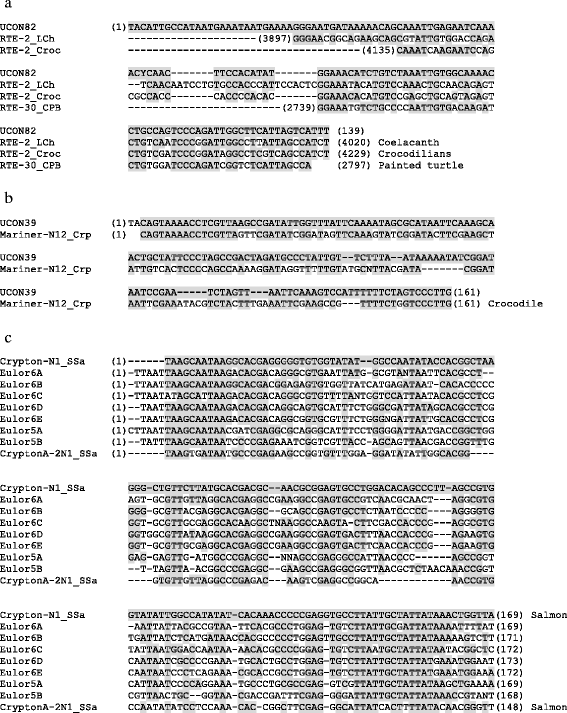Human transposable elements in Repbase: genomic footprints from fish to humans
- PMID: 29308093
- PMCID: PMC5753468
- DOI: 10.1186/s13100-017-0107-y
Human transposable elements in Repbase: genomic footprints from fish to humans
Abstract
Repbase is a comprehensive database of eukaryotic transposable elements (TEs) and repeat sequences, containing over 1300 human repeat sequences. Recent analyses of these repeat sequences have accumulated evidences for their contribution to human evolution through becoming functional elements, such as protein-coding regions or binding sites of transcriptional regulators. However, resolving the origins of repeat sequences is a challenge, due to their age, divergence, and degradation. Ancient repeats have been continuously classified as TEs by finding similar TEs from other organisms. Here, the most comprehensive picture of human repeat sequences is presented. The human genome contains traces of 10 clades (L1, CR1, L2, Crack, RTE, RTEX, R4, Vingi, Tx1 and Penelope) of non-long terminal repeat (non-LTR) retrotransposons (long interspersed elements, LINEs), 3 types (SINE1/7SL, SINE2/tRNA, and SINE3/5S) of short interspersed elements (SINEs), 1 composite retrotransposon (SVA) family, 5 classes (ERV1, ERV2, ERV3, Gypsy and DIRS) of LTR retrotransposons, and 12 superfamilies (Crypton, Ginger1, Harbinger, hAT, Helitron, Kolobok, Mariner, Merlin, MuDR, P, piggyBac and Transib) of DNA transposons. These TE footprints demonstrate an evolutionary continuum of the human genome.
Keywords: Crypton; DNA transposons; Human repeat; LTR retrotransposons; MER; Non-LTR retrotransposons; Repbase; SINE; Transposable elements; UCON.
Conflict of interest statement
Not applicable.Not applicable.The author declares that he has no competing interests.Springer Nature remains neutral with regard to jurisdictional claims in published maps and institutional affiliations.
Figures

Similar articles
-
Hagfish genome reveals parallel evolution of 7SL RNA-derived SINEs.Mob DNA. 2020 May 22;11:18. doi: 10.1186/s13100-020-00210-2. eCollection 2020. Mob DNA. 2020. PMID: 32489435 Free PMC article.
-
Genome-wide analysis of transposable elements in the coffee berry borer Hypothenemus hampei (Coleoptera: Curculionidae): description of novel families.Mol Genet Genomics. 2017 Jun;292(3):565-583. doi: 10.1007/s00438-017-1291-7. Epub 2017 Feb 15. Mol Genet Genomics. 2017. PMID: 28204924
-
Screening of Helicoverpa armigera Mobilome Revealed Transposable Element Insertions in Insecticide Resistance Genes.Insects. 2020 Dec 11;11(12):879. doi: 10.3390/insects11120879. Insects. 2020. PMID: 33322432 Free PMC article.
-
Structural and sequence diversity of eukaryotic transposable elements.Genes Genet Syst. 2020 Jan 30;94(6):233-252. doi: 10.1266/ggs.18-00024. Epub 2018 Nov 9. Genes Genet Syst. 2020. PMID: 30416149 Review.
-
DIRS-1 and the other tyrosine recombinase retrotransposons.Cytogenet Genome Res. 2005;110(1-4):575-88. doi: 10.1159/000084991. Cytogenet Genome Res. 2005. PMID: 16093711 Review.
Cited by
-
A novel colony-stimulating factor 1 (CSF1) translocation involving human endogenous retroviral element in a tenosynovial giant cell tumor.Genes Chromosomes Cancer. 2023 Apr;62(4):223-230. doi: 10.1002/gcc.23116. Epub 2023 Jan 5. Genes Chromosomes Cancer. 2023. PMID: 36504457 Free PMC article.
-
Repetitive DNA sequence detection and its role in the human genome.Commun Biol. 2023 Sep 19;6(1):954. doi: 10.1038/s42003-023-05322-y. Commun Biol. 2023. PMID: 37726397 Free PMC article. Review.
-
Expression of LINE-1 elements is required for preimplantation development and totipotency.Genes Dis. 2025 Feb 7;12(5):101555. doi: 10.1016/j.gendis.2025.101555. eCollection 2025 Sep. Genes Dis. 2025. PMID: 40600062 Free PMC article. Review.
-
Handling multi-mapped reads in RNA-seq.Comput Struct Biotechnol J. 2020 Jun 12;18:1569-1576. doi: 10.1016/j.csbj.2020.06.014. eCollection 2020. Comput Struct Biotechnol J. 2020. PMID: 32637053 Free PMC article. Review.
-
Inverted Alu repeats in loop-out exon skipping across hominoid evolution.bioRxiv [Preprint]. 2025 Mar 10:2025.03.07.642063. doi: 10.1101/2025.03.07.642063. bioRxiv. 2025. PMID: 40161837 Free PMC article. Preprint.
References
Publication types
LinkOut - more resources
Full Text Sources
Other Literature Sources
Miscellaneous

